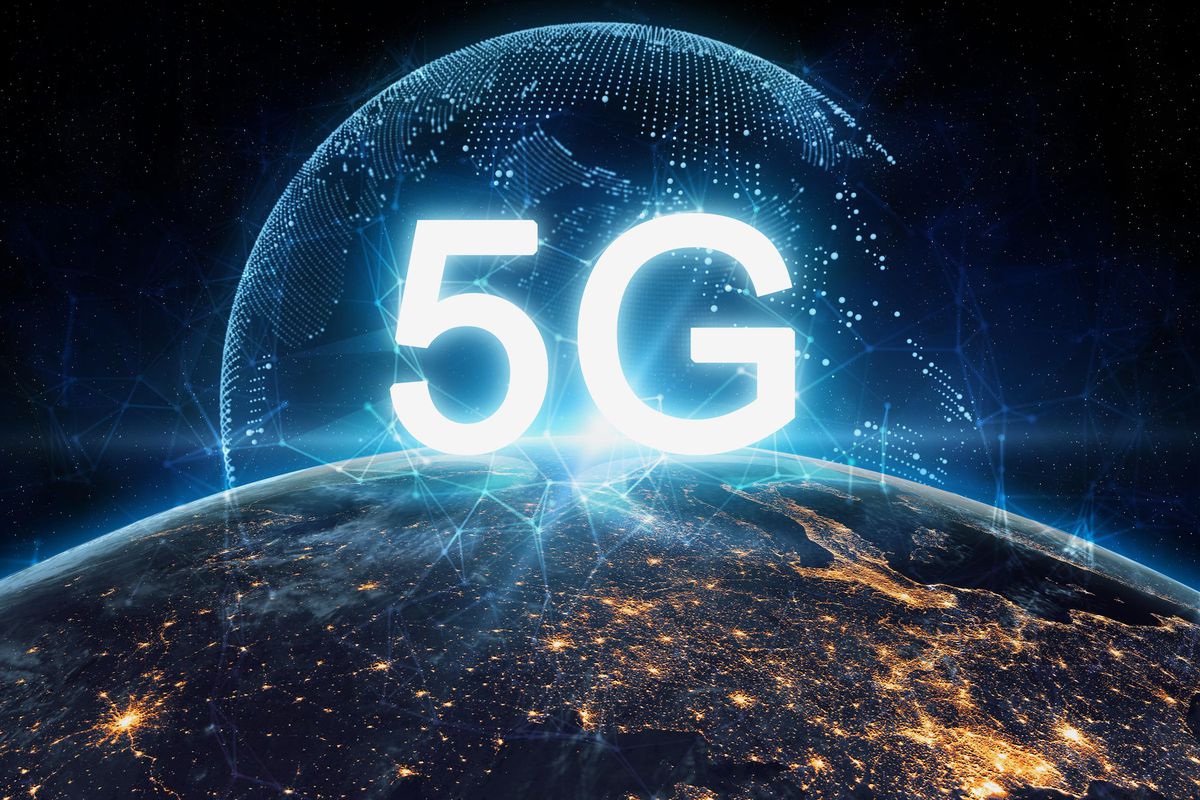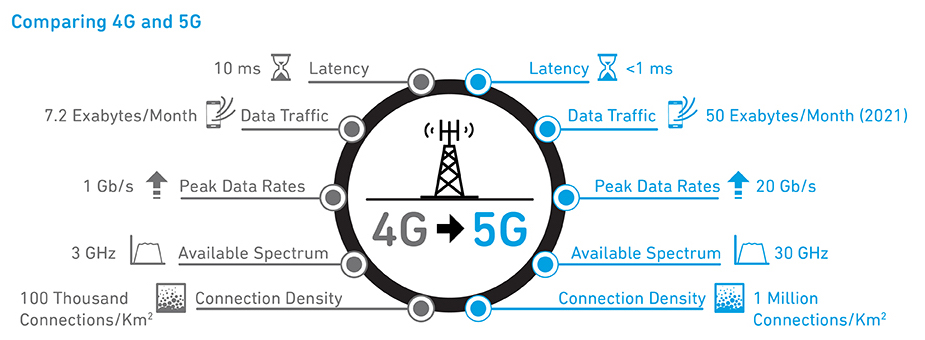5G TECHNOLOGY: A PRIMER

Reliance Industries Chairman said that policy steps are needed to accelerate early rollout of 5G, and to make it affordable and available everywhere, adding that as many as 300 million mobile subscribers are still trapped in the 2G era. Jio will pioneer the 5G revolution in India in the second half of 2021.
Wireless communication technology has grown and advanced significantly over the years through research and innovation. The time has come when we can connect various wireless technologies, networks, and applications simultaneously. This latest technology is called 5G. The fifth-generation wireless system (or 5G for short) is now the next generation of wireless communication systems
PREVIOUS GENERATIONS
- World of telecommunication has witnessed drastic changes starting from 1G to 2.5G and from 3G to 5G.
- 1G: analog telecommunications standard introduced in the 1970s for voice communications with a data rate up to 2.4 kps. It used FM and FDMA and a bandwidth of 30 kHz. The major problems with 1G are poor voice quality, poor battery quality, and large phone size.
- 2G: digital standard, circuit switched technology introduced in 1980s. It used CDMA, GSM, and TDMA technologies. It could only transmit digital voice at 64 kbps, and not data such as email.
- 2.5G and 2.75G: 2.5G introduced a new packet-switching technique that was more efficient than 2G technology. This led to 2.75G, which provided a theoretical threefold speed increase. 2.5G and 2.75G were not defined formally as wireless standards. They served mostly as marketing tools to promote new cell phone features to the public.
- 3G: used Code Division Multiple Access Technique (CDMA). It introduced high-speed Internet access. It used technologies such as W-CDMA and HSPA (high speed packet access). It provided IP connectivity for real-time and non-real-time services.
- 4G: works the same as 3G and may be regarded as the extension of 3G but with a faster Internet connection, more bandwidth, and a lower latency. 4G technologies such as WiMAX and LTE (Long-Term Evolution), claim to be about five times faster than 3G services.

5G
- As any other cellular network, 5G networks will consist of cells divided into sectors and send data through radio waves.
- 5G may transmit data over the unlicensed frequencies currently used for Wi-Fi. It promises a smarter, faster, and efficient network.
- In order to increase network efficiency, the cell is subdivided into micro and pico cells.
- 5G will be a new mobile revolution as it is expected to provide gigabit-per-second data rates anytime, anywhere.
- In a 5G wireless network, every mobile phone will have an IPv6 address depending on the location and network being used.
- 5G utilizes user-centric network concept World Wide Wireless Web (WWWW) instead of operator- centric as in 3G or service-centric as in 4G.
- 5G includes the latest technologies such cognitive radio, Internet of things, nanotechnology, and cloud computing.
5G technology has the following advanced features:
- Architecture will be device-centric, distributed, programmable, and cloud-based
- High data rates
- One to 10 Gbps connections to end points
- One millisecond end-to-end round trip delay
- Low battery consumption
- Better connectivity irrespective of location
- Larger number of supporting devices
- Lower cost of infrastructure development
- High throughput, improved spectrum efficiency, reduced latency, better mobility support, and high connection density
Major technologies enabling 5G include:
- D2D Communication: Direct connectively is achieved through device-to-device (D2D) 5G cellular network will implement D2D mm wave communication technology to provide high speed data rate, improve coverage, and offer peer-to-peer services. Much research effort has been invested of characterizing D2D connections as part of LTE.
- M2M Communication: While D2D communication targets mobile radios, machine-to-machine (M2M) expands the scope and facilitates ubiquitous connectivity among mobile It is estimated that there will be over 100 billion connected devices using M2M communications in 5G backbone.
- MIMO: Multiple-input-multiple-output (MIMO) technology plays a crucial role in 4G and is expected to play an important function in Massive MIMO extracts the benefits of MIMO on a large scale by increasing the throughput and spectrum efficiency.
- Other enabling technologies of 5G include mmWave communication, ultra-dense network (UDN), all-spectrum access (ASA), OFDM (orthogonal frequency division multiplexing), and Internet of things.
POTENTIAL APPLICATIONS
Some of the significant applications of 5G wireless technologies include:
- Virtual reality/augmented reality/tactile Internet
- Autonomous driving/connected cars
- Wireless cloud-based office/multiple-person videoconferencing
- Unified global standard for all
- Network availability anywhere anytime
- Blockchain
- 3D and ultra HD videos
- Smart gird
- Smart surgery and remote medical examination
- Mobile security
- In addition, 5G will allow one to pay all bills in a single payment with his/her mobile and vote from his/her mobile.

BENEFITS
- Faster speed: Data transfer speeds with 5G are projected to be about 10 times higher with 4G. That means significantly faster transmission of images and videos.
- Shorter delays: 5G should reduce latency (the time between cause and effect). This will make it possible, for example, to watch high-speed virtual reality video with no delays.
- Increased connectivity: 5G technology would will bring faster, more reliable connections for users than 4G/LTE. That means more people and devices will be able to communicate at the same time.
- Besides these benefits, 5G has excellent capability to support both software and consultancy.
- It has high data rate at the edge of the cell and better coverage area.
- It has low battery consumption.
- It is beneficial for the government, as it can make governance easier, and for the citizen, as it can provide Internet connectivity anytime anywhere.
4G vs 5G- DIFFERENCES

CHALLENGES
- The transition from 4G to 5G presents several transformational challenges which must be tackled to fully realize the 5G vision.
- There are challenges faced with the new technologies enabling 5G.
- There are also challenges with the integration of this technology to provide services in different application scenarios.
- Some have criticized 5G for its high projected cost and that it is incompatible with the previous
- Just as 2G phones could not connect to 3G or 4G networks, 3G and 4G phones will not connect to a 5G network. One is forced to buy a new phone which is likely to be more expensive than 4G/LTE
- Physical objects block 5G signals easier than 4G, and, even when unobstructed, 5G signals do not carry as far. This means that more towers are needed to support a comprehensive network. While a few 4G towers might support a moderately-sized city, with 5G, dozens will likely be needed, as towers are required throughout the service area to maximize coverage.
- One remaining hurdle is the usage and popularization of 5G-capable phones and devices.
To address these challenges, we need a drastic change in the design of cellular architecture. We also need to meet 5G system performance requirements such Mfentocells, stringent latency, network scalability, very long battery life, and green communications. It is a challenge to satisfy these requirements and minimize costs at the same time.
5G TRIALS
- In April, South Korea and the U.S. became the first countries to commercially launch 5G services. South Korea claimed it was the first to do so, beating the U.S. by a couple of hours, a claim disputed by U.S carriers. China too has handed out commercial 5G licences to its major carriers earlier than expected.
- More than 150 pre-commercial 5G trials are underway around the world. A major showcase was in South Korea, where Korea Telecom, working with Samsung Electronics, Intel and Ericsson demonstrated a 5G network during the Winter Olympics in PyeongChang.
- In the US, Verizon and AT&T are carrying out 5G trials (both mobile and fixed access) across several cities.
- Several trials are also underway in China. In Europe, several trials are underway with a focus on delivering services to high speed vehicular subscribers like cars on motorways and intercity trains.
5G IN INDIA
- India’s history with wireless services began early.
- The first experimental wireless telegraphy links were demonstrated as early as 1902.
- A Department of Wireless Telegraph was created soon thereafter, and wireless telegraphy came into routine use in Calcutta at Diamond Harbour in 1908.
- The first mobile phone service was launched in 1985 on a non-commercial basis, but it was only in 1995 that commercial service was started.
- The initial subscriber growth was modest, however new policy initiatives, beginning 2007, spurred rapid growth with the subscriber base reaching 560 million in 2009 and well over a billion by 2017.
- Early deployment of mobile networks was based on 2G technology, with 3G technology entering service in 2010 and 4G in 2016.
- 4G networks now serve 240 million subscribers in urban areas across the country.
- LTE coverage in rural areas remains a challenge.
- 4G link speeds in India are picking up, averaging 6-7 Mbps as compared to 25 Mbps in advanced countries.
- The Government has launched a program titled ‘Building an End-to-End 5G Test Bed’ to advance innovation and research in 5G. This three year program began in March 2018, with a budget authorization of Rs 2,240 million. The program has been awarded to IIT Madras, IIT Hyderabad, IIT Delhi, IIT Kanpur, CEWIT, SAMEER and Indian Institute of Science (IISc), Bangalore. The program envisages close collaboration between the universities and small technology companies. The goal of the program is to build proof-of-concept 5G prototypes that are broadly compliant with the 3GPP standards. Several smaller academic R&D programs around 5G themes have also been funded by DST and MEITY.
- Ericsson has installed the first public access 5G test bed at IIT Delhi in July 2018 for developing applications in the broadband and low latency areas providing access to the industry and institutions to work on India specific usage scenarios and applications.
- On the standards front, DoT and TSDSI in collaboration with the IITs have been successful in getting the Large Cell Low Mobility (LMLC) use case accepted in the IMT 2020 requirements.
- 5G High Level Forum was set up by the Government in 2017 to articulate the Vision for 5G in India and to recommend policy initiatives and action plans to realize this vision. It aims to achieve a globally-competitive product development and manufacturing ecosystem targeting 50% of India’s market and 10% of global market over 5-7 years.
- Cellular Operators Association of India (COAI) has formed the 5G India Forum (5GIF) that is expected to serve as a national initiative where all stakeholders, private and public, small and large, can meet and discuss the challenges of making 5G a reality in India, in conjunction with leaders of the rest of the world.
- The National Digital Communication Policy-2018 (NDCP-2018) also lays out the following objectives with respect to 5G services in India: Enabling Hi-speed internet, Internet of Things and M2M (Machine to machine) by rollout of several 5G technologies etc.

5G Relevance to India:
- 5G has been designed for global adoption with flexibility to support wide number of applications.
- Its adoption in India will involve many use cases adopted widely in the world, but also some unique applications to suit India’s needs.
- 5G’s value for India may be even higher than in advanced countries because of the lower levels of investments in physical infrastructure.
- 5G may offer ‘leapfrog’ opportunities by providing ‘smart infrastructure’ that offers lower cost and faster infrastructure delivery.
- 5G technologies will offer even more opportunities in infrastructure efficiencies. For example, 5G will enable ‘vehicle platooning’, a technology that exploits 5G’s low latency communication capability to pack vehicles into platoons with low inter-vehicle spacing despite travelling at high speeds.
- 5G will allow rapid coordination between the vehicles and keep the vehicles in the platoon safe. Platooning can double vehicle density in roads promoting efficient and safer use of the limited road infrastructure.
- In manufacturing, 5G will enable use of robotics for precision manufacturing, particularly where humans cannot perform these functions safely or with the necessary precision.
- 5G can also enable better logistics to track goods from raw materials to product delivery and improved sharing of expensive design and manufacturing resources across the country.
- In agriculture, 5G can enable improvement in the entire value-chain, from precision farming, smart irrigation, improved soil and crop monitoring, to livestock management.
- In the energy sector, ‘smart grids’ and ‘smart metering’ can be efficiently supported enabling growth of alternate energy technologies. With the rise of renewable and storage technologies, low latency communications will be critical to manage these grids.
- In health-care, 5G can enable more effective tele-medicine delivery, tele-control of surgical robotics and wireless monitoring of vital statistics.
What will be the economic impact?
- 5G is expected to create a cumulative economic impact of $1 trillion in India by 2035, according to a report by a government-appointed panel. According to a separate report by telecom gear maker Ericsson, 5G-enabled digitalisation revenue potential in India will be above $27 billion by 2026. Additionally, global telecom industry GSMA has forecast that India will have about 70 million 5G connections by 2025.
- 5G will require a fundamental change to the core architecture of the communication system. Simply upgrading the existing Long Term Evolution core will not be able to support the various requirements of all 5G use cases. A report on 5G by Deloitte stated that it is anticipated that the industry might require an additional investment of $60-70 billion to seamlessly implement 5G networks. Ernst & Young too estimated a similar amount of investment to implement 5G.
- Two of the three private telcos, Bharti Airtel and Vodafone Idea, expressed apprehensions about the 5G auction. They pointed out that the reserve price of the airwaves is very high. Besides, there are currently no India-specific use cases for deployment of 5G.
- Telecom industry body Cellular Operators Association of India (COAI) has also expressed concerns about the financial health of the sector amid intense competition and recent phase of consolidation. Currently, the industry’s cumulative debt is pegged at around ₹7 lakh crore.
- The COAI has also pointed out that 5G is overpriced by at least 30% to 40% compared to international standards and auction in other markets such as South Korea and the U.S.
The 5G wireless technology is a multipurpose wireless network for mobile, fixed and enterprise wireless applications. It incorporates all type of advanced features that makes it powerful and in huge demand in near future. It has a bright future and will be a revolution in the mobile market.








